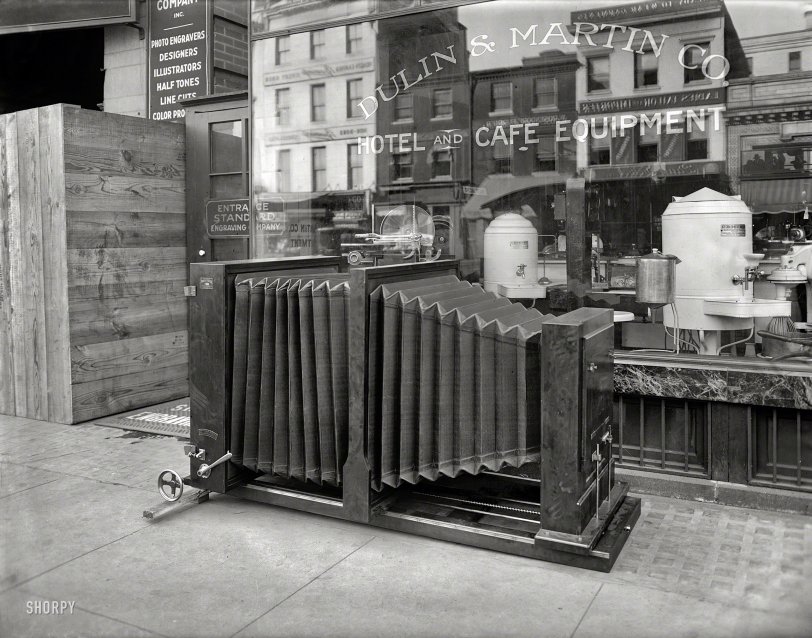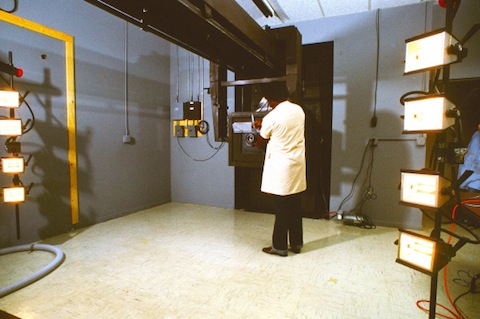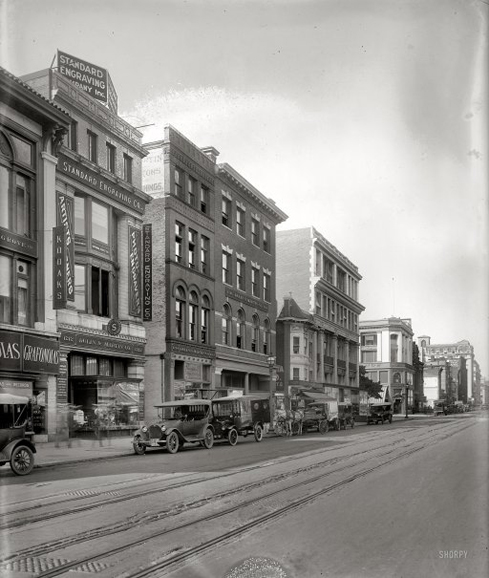


Framed or unframed, desk size to sofa size, printed by us in Arizona and Alabama since 2007. Explore now.
Shorpy is funded by you. Patreon contributors get an ad-free experience.
Learn more.

- Freeze Frame
- Texas Flyer wanted
- Just a Year Too Soon
- WWII -- Replacing men with women at the railroad crossing.
- Yes, Icing
- You kids drive me nuts!
- NOT An Easy Job
- I wonder
- Just add window boxes
- Icing Platform?
- Indiana Harbor Belt abides
- Freezing haze
- Corrections (for those who care)
- C&NW at Nelson
- Fallen Flags
- A dangerous job made worse
- Water Stop
- Passenger trains have right of way over freights?
- Coal
- Never ceases to amaze me.
- Still chuggin' (in model form)
- Great shot
- Westerly Breeze
- For the men, a trapeze
- Tickled
- Sense of loneliness ...
- 2 cents
- Charm City
- What an Outrage
- Brighton Park
Print Emporium
Major Bellows: 1920

Washington, D.C., circa 1920. "Standard Engraving Co. big camera." Specifically, The Levy Process Camera. National Photo glass negative. View full size.
Good reason why it's on the sidewalk
Camera 4 feet wide. Door to Standard Engraving 3 feet wide.
One pane, two reflections
With a single pane of glass you can get a reflection from both the front and the back surface of the glass. This is most easily observed when the area behind the glass is dark.
What is painted on the glass will be in focus, and reflections from across the street will appear doubled because of the two reflections from the single sheet of glass.
Blurred image
I would tend to blame it on limited depth of field in the shot. The photographer focused somewhere just beyond the process camera, and had to use a relatively large aperture to get the exposure placement. The reflection of the buildings across the street could be well past the hyperfocal distance.
RE: double reflections
I think tterance is closer to the correct solution, though I think it is a single glazed window, though rather thick.
Glass reflects from both surfaces. If it is rather thick, as this seems to be and as expected given its large size, and you look at an angle rather than perpendicularly, the two reflections will be displaced from one another. The direction of the displacement in this image along with the fact that the displacement diminishes as you look toward the lower right corner, where you are looking almost straight into the glass, indicates a double reflection. If it had been double glazed, there would be four reflections.
Reflection
Single pane plate glass has thickness and two surfaces for light to bounce from, much like a mirror. Notice that the image is not blurred, it's doubled and for the most part the paired image grows apart as the angle increases. The blur across the entire reflection is simply that the camera was not focussed there. The process of hand blowing cylinder plate glass in the early days made for very uneven glass in waviness and thickness so a linear difference in the two reflections would be diffucult. Study objects in a mirror at an angle, a second image appears which is not seen at 90 degrees.
Max Levy
and his brother Louie, in 1890, perfected the technology of the glass halftone screen, and the cameras that used them, which allowed photographs to be made into printing plates. Before that time only line drawings or even woodcuts were used to reproduce simulated images.
And in deference to "k2", this old photoengraver who has made thousands of halftone plates utilizing Levy process cameras, ain't ready for the dustbin yet!
Flexing theory
You know, it could be flexing... "Ladies Tailor & Importer" is not doubled in a parallel way. There's more distance between the doubles at the left side than the right. The glass would bow more toward the center and less around the edges.
Goodbye, Bellows!
Biggest bellows I ever used was on this Robinson Log-E horizontal camera at Martel Labs back in the 1980s. In this photo, the bellows were compressed, but you can see the rail above and the bellows could extend for five feet or so.
This photo was taken in the lens/bellows room of this two-room setup. What you were photographing was on a large vertical-glass vacuum frame illuminated by the two racks of lights shown and the other room was where the camera controls and backplate of the camera were. You could "blowback" to shoot backwards if you needed to shoot onto film bigger than 24" x 24" but that was seldom done.
This camera was used for graphic arts photography; Martel was a classified cartographic lab in St. Pete, Florida, where I was the photo-lab manager in those olden days.

1212 G Street, NW
Storefront previously seen on Shorpy here.

Another Theory about the Blurry Reflection
While "tterraces" Double-Pane window being the cause of the blurry reflection makes complete sense I have another theory that might also be possible...
Let's assume it is a single pane window that will flex slightly if the air pressure inside the building changes. This could happen if a door or window is opened.
Possibly during the exposure someone opened a rear door or window somewhere in the building and the large window glass flexes as a result. This very slight flexing would have very little affect on the focus/position of the lettering on the actual glass, but the position of the reflection from across the street would be magnified and create the double image that we see.
How common were double pane windows in the 1920 era?
[If it was a single pane, the flexing would cause the lettering on the glass to be doubled as well. -tterrace]
Looking at the double reflected image it is most noticeable in the center of the window where the glass flex would have the highest displacement. The edges of the window near where the glass is secured to the frame does not show as much doubling of the image since it cannot move as far.
The relatively small amount of movement even in the center of the window will have a negligible effect on the actual focus of the window's lettering, but the greater distance to the reflection from across the street will result in a larger shift of reflected image's position.
Dead tech
Not much call for a process camera these days, just another little piece of the past's magic gone to history's dustbin. With most of the guys who knew how to use 'em, too.
Call me obtuse
Can someone explain why the lettering on the buildings across the street, as reflected in the window, are blurry as from motion, not exposure time? Yet, the lettering on the subject window is perfectly sharp. If there was camera shake, everything in the photo would be jumpy. Earthquake only on the other side of the street? The answer is there somewhere.
[My guess: a double-pane window. -tterrace]
Reflections
I see "W. Rosendorf Furrier" and a business that is a "Ladies Tailor & Importer" making "Ready to Wear Garments."
Nice title
However Dr. Bellows was a Colonel.
["The perfect is the enemy of the good." - Dave]
























On Shorpy:
Today’s Top 5